The Black and White casqued hornbill
The Black and White casqued hornbill
The Black and White casqued hornbill : also known as the Grey-cheeked hornbill fairly large and mainly black hornbills. In addition, they have white lower backs and rumps, upper and under tail-covers, thighs, bellies and vents. Furthermore, the central pair of the flight feathers on the tail is all black while the rest of the tail feathers are basically black. Additionally, the secondaries and inner primaries are mostly white with bases being black. The bird has a Grey-tipped facial feathering, deriving the other common name “Grey-cheeked Hornbills”. Movements and dispersion of these hornbills vary seasonally and this specie is also diurnal and usually travel in pairs or small groups.
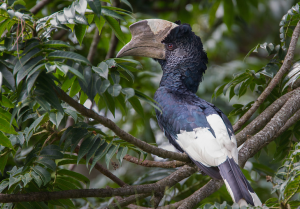
Physical description
It is recognized by its black plumage for the higher body and wings alongside and white plumage on the lower body. They have wings with black feathers amongst the white feathers of the tail. It has a broad creamy-brownish bill and flattened casque, which are enlarged in males. Males have red eyes, blackish facial skin and a dark brown bill with a high ridged, laterally flattened casque. On the other hand, females have pink facial skin and brown eyes and have much smaller all-blackish bills. In addition, the casque is decreased to a lower rounded ridge on the basal upper mandible.
In males, the purpose of the casque is not clearly known although it is suggested to be for sexual characterization. Besides, the specie has mobile eyes something not common in birds. This means that their eyes roll themselves in their socket while other birds have to move their heads to see around. The bird is also capable of displaying emotions through the feathers at the top of the head. This basically allows it to communicate out its emotional state. However, juveniles emerging from the nest have small bills lacking casques. Birds less than a year of age have brown feathers on the forehead and around the base of the bill. The facial feathers turn from brown to grey by the age of 10 months
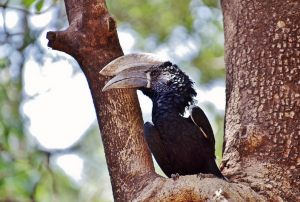
Feeding
These birds are mainly frugivorous, with fruit comprising 90% of their diet. They basically forage by hopping from one branch to another in the forests reaching out for fruits. This is done with its tip of the bill which they then swallow wholly. They are also frequently seen foraging alongside monkeys and squirrels. This bird is well known to consume over 41 plant species in general.
In addition, the species consumes other bird’s eggs, insects, bats, snails, lizards, etc. Mosses, fungi and lichens are also comprised in their diet. With this bird, the carnivorous component of the diet is increased during the breeding period. It does not consume water directly but instead hydrates itself from the water contained in the fruits that represent most of its diet. During the dry season, this species does not nest, they are nomadic, sometimes travelling over 6km to visit fruiting trees.
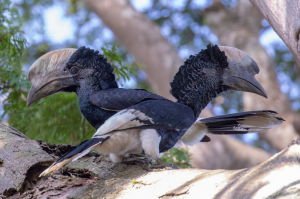
Reproduction
These hornbills are basically monogamous (having one mate at a time). In fact, they breed seasonally from January to May in Central Africa and August to March in eastern Africa. On the other hand, their breeding season coincides with local rainy seasons. This is so such that they can take advantage of the abundance of fruit and arthropods at this time. The individuals nest in naturally formed cavities 9 to 30m high in large forest trees. Due to the rarity of the nesting cavities, there is an increased degree of intraspecific competition for nesting sites. The female does most of the work and the material is brought to her by the male.
When nesting, the birds keep the material in the tips of their bills and make rapid sideways vibrating movements of their bills. Additionally, the female lays a clutch of 2 eggs, which are white in color with pitted shells. The eggs are incubated for 42 days while the male delivers food to the female hourly through a small slit. It regurgitate numerous fruits, mammals and insects and the male can bring up to 200 fruits per visit. Normally only one offspring is reared, with the chick from the second laid egg dying of starvation. Newly hatched chicks have pink skins and open their eyes at the age of approximately 20 days. The offspring fledge at the age of nearly 70 to 79 days and can feed themselves by 40 to 72 days after fledging. These birds make continuous and repetitive “long-calls” and “high-pitched screams” whilst perched on tree tops.
Communication
The birds are absolutely vocal, with a large collection of calls one of which can be heard from a distance of 2km. They make repetitive “long-calls” and “high-pitched screams” while perched at tree tops. It is theorized that the casque on the bill of this specie acts as a vibrating chamber to make their voice sound more powerful.
Where to find them
The black-and-white casqued hornbill is found mostly in Ivory-Coast, with smaller populations in its surrounding countries of West-Africa. The Central-African populations are mostly in Uganda and Kenya as well as Cameron with smaller populations in Gabon, Tanzania and Central Africa.

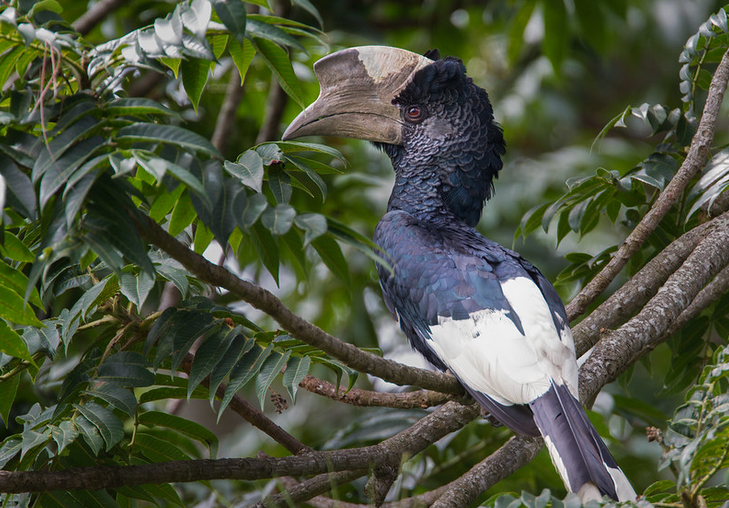






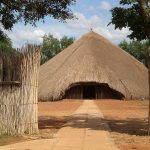


It is a really amazing powerful resource that you’re offering and you just provide it away cost-free!! I really like discovering websites of which are aware of the particular property value providing you with beautiful learning resource for zero cost. We truly dearly loved examining this page. Be thankful!
I am very happy to read this. This is the type of manual that needs to be given and not the random misinformation that’s at the other blogs. Appreciate your sharing this greatest doc.
Spot on with this write-up, I actually assume this website wants much more consideration. in all probability be again to read way more, thanks for that info.
You made some decent points there. I looked online for any problem and found most people may go along with with your web site.
You made some tight points there. I looked on the web for the difficulty and found most individuals will approve together with your blog.
Hiya! I just wish to give a huge thumbs up for the great data you’ve gotten here on this post. I shall be coming back to your weblog for more soon.
I’m impressed, I must say. Actually rarely must i encounter a weblog that’s both educative and entertaining, and let me tell you, you may have hit the nail for the head. Your notion is outstanding; the pain is something that not enough individuals are speaking intelligently about. My business is happy we found this at my seek out something regarding this.
I am usually to running a blog and i actually recognize your content. The article has really peaks my interest. I am going to bookmark your website and keep checking for new information.
woow…great God’s creation.
thanks for this.